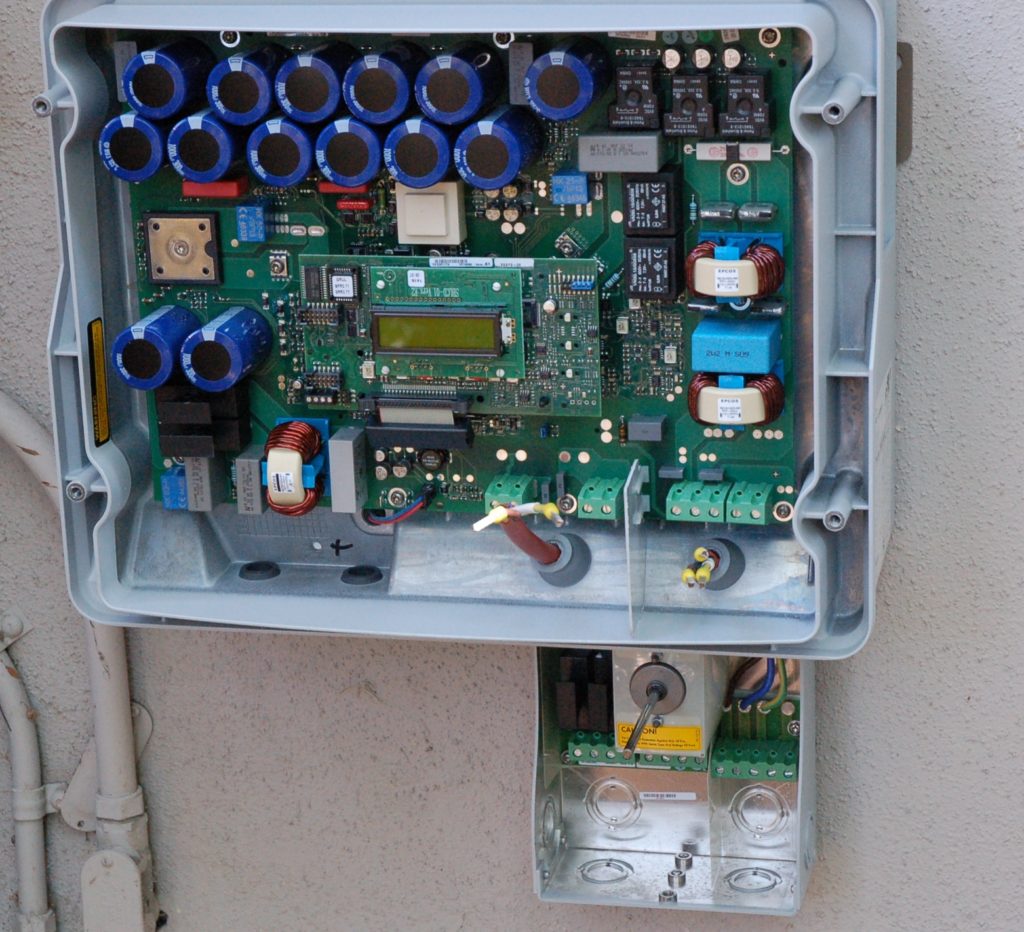Single-phase and Three-phase
Central inverters
In-Circuit Testing
Through Hole Technology
Surface Mount Technology
Solar Inverters Online Tools
Solar Inverter Manufacturers
Components of Solar Inverters
[...]
What components are solar inverters made of?
Inverters have to convert DC to AC. Grid tied inverters will have to ensure the output is locked to the grid. There are three prime functions involved: switching, filtering, and control of amplitude and frequency. In addition MPPT function may also be implemented within the same functions. The switching is now primarily through field effect transistors (FETs - mono polar semiconductors), and triacs, but insulated gate bipolar junction transistors (IGBIT) may be found in some designs. FETs offer low conduction losses in switching mode. In the most basic (square wave inverter) DC energy is supplied to the FETs connected in each leg of a tapped transformer. Control circuitry switches the legs alternately to allow out of phase currents in the legs. Another step-up winding is also present which gets the ac output. Inductors and capacitors are used to filter the output. Square wave inverters are now confined to underdeveloped countries only. For more : https://www.mpptsolar.com/en/how-does-an-inverter-work.html Pure sine wave inversion will involve a conversion from DC to high frequency, back to DC, and another conversion to mains frequency along with filtering. Maximum power point tracking will be effected in the very first stage. Sine wave pulse width modulation (SPWM) of energy at high frequencies allows a pure sine wave output. The output is sampled, rectified and fed back to the control circuitry which regulates the amplitude, frequency, and phase. Control including PWM is normally accomplished through a microcontroller. The high frequency switching used for SPWM has another advantage. Lighter transformers can be utilized reducing the overall weight significantly.Between the pure sine wave and square wave inverters is the modified sine wave which is now confined to developing countries.The transformer provides isolation between the ground on the load side and the panel side of the inverter. But it contributes significantly to weight of the inverter. As ungrounded panels are now allowed, transformerless inverters are becoming more popular. Elimination of the transformer reduces the weight and improves efficiency of the inverter by about two percent. Where large powers are involved this two percent will also be significant.
Pure sine wave inversion will involve a conversion from DC to high frequency, back to DC, and another conversion to mains frequency along with filtering. Maximum power point tracking will be effected in the very first stage. Sine wave pulse width modulation (SPWM) of energy at high frequencies allows a pure sine wave output. The output is sampled, rectified and fed back to the control circuitry which regulates the amplitude, frequency, and phase. Control including PWM is normally accomplished through a microcontroller. The high frequency switching used for SPWM has another advantage. Lighter transformers can be utilized reducing the overall weight significantly.Between the pure sine wave and square wave inverters is the modified sine wave which is now confined to developing countries.The transformer provides isolation between the ground on the load side and the panel side of the inverter. But it contributes significantly to weight of the inverter. As ungrounded panels are now allowed, transformerless inverters are becoming more popular. Elimination of the transformer reduces the weight and improves efficiency of the inverter by about two percent. Where large powers are involved this two percent will also be significant.